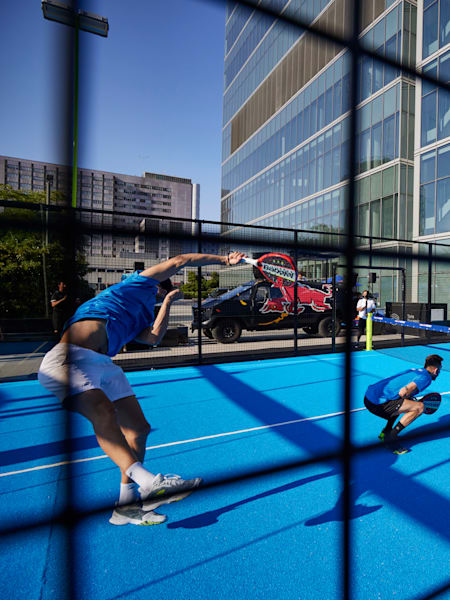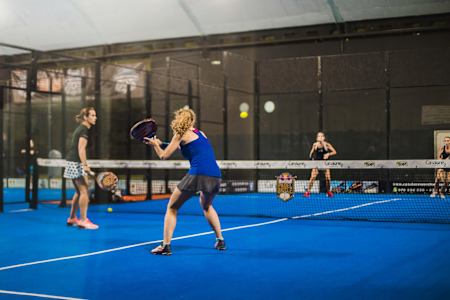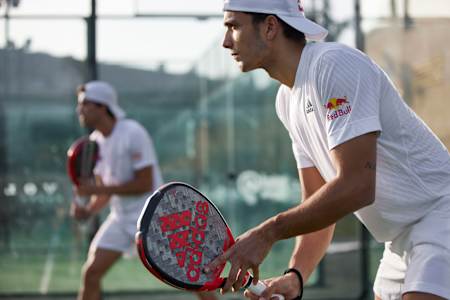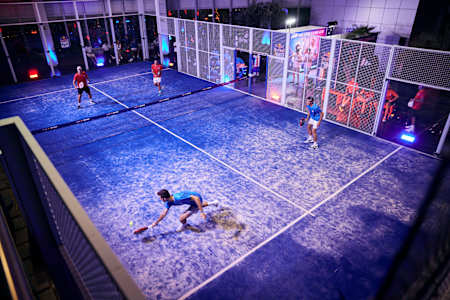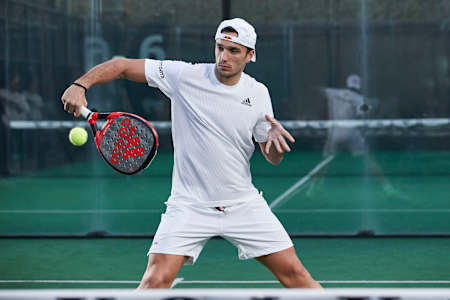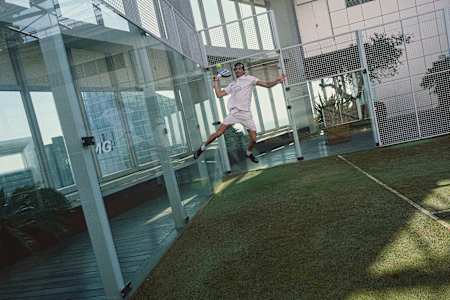Padel is one of the fastest growing sports in the world in terms of numbers playing. According to the governing body, the International Padel Federation (FIP), padel is now played by around 25 million people across the globe with the game enormously popular at a grassroots and professional level in countries such as Mexico, Argentina and Spain. FIP estimates that there are courts in over 90 countries.
Premier Padel comes to the U.S. for the first time, stopping off in Miami for a thrilling P1 tournament on March 21-23, 2025. Watch all the matches from quarter-finals to finals on Red Bull TV.
What exactly is the racquet-based ball game all about? Scroll on down to find out more about the origin, equipment, rules and the stars who play this game.
01
What is padel?
Padel is a racquet-based ball sport that could be described as being a mixture of squash and tennis. It is played within an enclosed space like squash but shares similarities with tennis.
So the game is played with a net in the middle like tennis, the court also looks very similar. Like tennis, the players must pass a ball over the net into an opponent's side by hitting a ball with their racquet. However in padel, the walls/fence of the enclosed court are firmly part of the sport's gameplay. Players are allowed to hit a ball after it bounces off a wall/fence in order to keep the ball in play.
Padel is most commonly played by four people in a game of doubles, though it can also be played individually. Playing as pairs harks back to the games social origins.
02
The differences between tennis and padel
As mentioned above padel takes its influence from tennis and anyone who watches a game of padel can't fail to notice that everything plays out like a game of tennis. There are differences, the key one being padel is played in an enclosed space. Below are also the difference you'll notice.
- Court size: a padel court is smaller than a tennis court. A padel court doesn't have the same line markings as a tennis court.
- Enclosed walls/fence: they are part of the court and play a part in gameplay
- Racquet: a padel racquet looks similarly shaped to a tennis racquet but is smaller and not stringed.
- Balls: the balls used in padel are smaller in diameter than a tennis ball despite looking the same
- Serving: in padel, the serve is by underarm and not overhead like tennis
- Technique: padel is not so much a power-based game like tennis
03
Where did padel begin
A Mexican – Enrique Corcuera – is seen as the origin founder of the game that is played today. Corcuera built a court to play a racquet-based ball game at his home in Acapulco in the late 1960s but this court was a little bit smaller than a tennis court due to property constraints. He found that if tennis balls were overhit they would go all over the place and into neighboring houses so he surrounded the court with walls on all sides.
Normal tennis racquets generated too much power on his court so Corcuera and his friends eventually adopted a wooden beach paddle bat to play with. A rulebook evolved, which allowed the players to play off walls and the rest is history.
From those Mexican beginnings, padel gained popularity mainly due to the enthusiasm of Corcuera's friends for the game they played at his property. In 1974, a friend, Prince Alfonso de Hohenlohe-Langenburg, took the game to Spain while de Hohenlohe’s friend, Julio Menditengui, was instrumental in introducing the game to Argentina. In both countries, the game took off to the extent they are the countries second most popular sports outside of football.
04
What do you need to start playing padel?
The court
The playing area of padel court measures 20x10 meters wide. Each half of the court is a perfect square of 10×10 meters. All lines on the court have a width of 5 centimeters. The net at the centre line of the court is 10 meters long and should be 88 centimeters high at the centre and 92 centimeters at the end.
Courts are typically enclosed by a combination of perspex glass (or solid concrete) walls and wire mesh. The back walls on the court should always be perspex glass and be three meters high. These walls are then topped with 1m of wire mesh. The side walls are part perspex glass and part wire mesh and should be three meters high also.
There are two gates at either end of the net on the side of the court and they are kept open during play as the rules of padel allow you to play a point out of the court. The court surface may be concrete or synthetic grass or carpet.
The racquet
There's no long-handed stringed racquet in padel like there is in tennis. A padel racquet looks very different as a result. It has a short handle and a foam core with an outer shell that could be anything from fiberglass to carbon fibre to graphene. A padel racquet must not measure more than 45.5 centimeters long, 26 centimeters and it should have a thickness of 38 mm.
One of the peculiarities of a padel racquet is that they are perforated with holes throughout. These holes are there to reduce the weight of the racquets. Racquets are classified around type also: Diamond (greater power), Teardrop (Control and power) and Round (greater control).
The balls
Padel balls are very similar to standard tennis balls in look but are smaller in diameter and carry less pressure.
The International Padel Federation (FIP) regulations specify that the ball must be made of yellow or white rubber and have a diameter of between 6.32 and 6.77 centimeters, while the weight must be between 56 and 59 grams. The ball must have an internal pressure of between 4.6 and 5.2 kilograms.
05
What are the rules of padel?
The rules for padel are similar to tennis in many ways but there are also differences here.
Padel scoring
Scoring largely follows that of normal tennis
- A point in padel is awarded if: the ball bounces on the ground twice on a player's side; a player hits the ball into the net; a player hits the ball outside the play area or directly against an opponent wall/fence without the ball bouncing first.
- Like tennis, matches are made up of three sets or five sets. The first player or team who wins two out of the three sets (or three, when five sets are played) wins.
- The first player or team to win six games wins the set. A team must have a lead of two or more games to win the set.
- In the professional game, a tie-break is played if a set goes to six games each. The first to seven points wins the tie-break.
- Games follow the point scoring of tennis also. So scores go up as 15, 30, 40, Game. If the scores are level at 40-40 this is a deuce. Two consecutive points need to be won from deuce in order to win the game. In the professional game, at 40-40, a golden point is now in operation.
- Players change their side of the court every time an odd game number is played.
In-game rules
- Serve is by underarm into the opponent's court diagonally from where the server is standing. The server has to let the ball bounce once behind the service line before serving and the ball must be hit by the server below their waist level. The serve must bounce in an opponent player's service box. If the ball bounces onto the fence that is considered a fault, if it hits a wall then play can continue.
- In play, you return the ball once it bounces off the surface on your side. You can also play the ball if the ball bounces onto a wall or fence and rebounds off it. You are allowed to volley but that return ball must not hit the glass perspex walls/fence directly.
- A player can play the ball against a wall on their own side of the court but not off the fence parts of the court.
- A player can leave the court to play a shot if the court has exit gates. This situation arises when a ball bounces on the opponent’s side of the court and then bounces over the perspex glass wall/fence. Players can exit the court in order to return the ball before it bounces a second time.
06
Padel tips for starters
Though padel is a sport that you can jump straight into and play, there are many intricacies to the game, the tactics you can employ and shots you can play. Here's some tips for those who are interested in playing or are just starting out.
Wall play – playing the ball off a perspex wall is a major part of the game so don't avoid using it; the wall is not your enemy. When the ball bounces off the wall it loses speed so you actually have time to consider what shot you can play more so than just off a normal return off the surface.
Court position – When positioning at the back of the court, you should stand on the same line as your partner. The ideal position is one step back of the service line and two steps back of the side of the court. At the net, don't stand too close. Instead take a position two to three steps back from the net.
Ease off the power - focus on just getting the ball back across the net and into play continuously. This will allow you to learn on how to control the ball with your racquet properly. Padel is not a power-based game even at pro levels.
Shoes on court – Many players new to the sport will just choose tennis shoes but actually playing padel puts incredible strain on athlete's achilles tendons. So choose specific padel shoes from recognized manufacturers as they'll offer maximum comfort and cushioning that is specific to the stresses that a padel player undergoes.
07
Names to watch out for
Given its origins padel tennis is unsurprisingly dominated by players from Spain and Argentina.
- Juan Lebron – The Spanish national is the current International Padel Federation number one ranked player and current World Champion
- Alejandro Galán – Playing partner of Lebron and also a current World Champion with him for the Spanish national team
- Fernando Belasteguin – A legend of the sport. The Argentinian is still playing at the highest level at the age of 43
- Arturo Coello – One of padel's young guns who is making a major impact. The Spaniard is the youngest winner of a WPT tournament at the age of 19
- Bea Gonzalez – The poster girl of padel's women's game given her success at a young age. At 21, the Spaniard is already a European and World Champion
- Alejandra Salazar – A Spanish female padel player who has over 50 titles to her name on the World Padel Tour.

